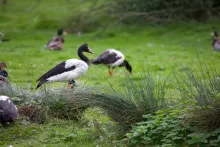
Magpie Goose (Anseranas semipalmata)
Species name
- Dutch name:
- Ekstergans
- English name:
- Magpie Goose
- German name:
- paltfußgans
- French name:
- Canaroie semipalm
- Scientific name:
- Anseranas semipalmata
Scientific classification
- Order:
- Anseriformes
- Family:
- Anseranatidae
- Genus:
- Anseranas
Description
- Description:
Male:
Has black and white plumage. It has black head, neck, upper breast, wings, rump, tail and thighs.
The underparts, underwing-coverts, mantel, lesser upperwing-coverts and uppertail-coverts are white.
On the head, the male has a protuberance at the top of the crown, varying in size. The facial skin is red. The bill is greyish-horn with red cere. The eyes are dark brown. Legs and semipalmated feet are orange to reddish.
During the dry season, the underparts are often tinged rufous, due to stagnant muddy waters.Female:
Has similar plumage but she is smaller with smaller knob on crown.Juvenile:
Is greyer and mottled. It has dull black areas, and white, washed brownish rest of plumage. Bill and facial skin are grey. The knob is absent and grows little by little.
Standard Measurements
- Body Length (cm):
- The male (drake) of the Magpie Goose measures approximately 77-90 centimeters. The female measures approximately 75-90 centimeters.
- Body Weight (grams):
- The male will weight about 2800 gram. The female will weight about 2000 gram.
The weight is notoriously variable and can only be used as indication!
- Note:
Magpie geese are ideally kept full-winged in a large, high aviary with high perches provided; they normally perch in trees in the daytime and roost on perches at night.. Magpie geese are prone to Frostbite in very severe weather and may lose toes as a result. A frost-free and possibly heated shelter for roosting should be provided in winter, or a weather-proofed electric heat lamp over a pile of dry straw in an outside enclosure may be used. They are less prone to Frostbite if they are able to perch off the ground.
Magpie geese breed variably in captivity, and may breed best if left full-winged. Fully-winged birds nest above ground level, although pinioned birds may build a substantial nest on the ground, or on a low platform if provided. Frequently form trios (male and two females), usually with the females related. Mate formation may be best encouraged by introducing a juvenile male and two females, possibly sisters. Pairing of adult birds may take years. Copulation normally occurs at the nest. Eggs may be laid as early as April and as late as September, with re-laying if eggs are removed and up to four clutches laid in a season. Nesting and egg laying appears to be stimulated by prolonged periods of heavy rain. All adults share incubation and care for the young.
- Breeding:
- The female Magpie Goose usually lays from 5-11 off-white eggs and incubates them for 25-28 days.
- Bird banding:
- Recommended closed leg band ring size for the Magpie Goose is 18 mm.The leg band ring can only be applied on a young magpie goose at around 16-18 days old.
- It doesn't matter what leg that you band, but it's good to have a consistent system. Suggested: Left leg = Female, Right leg = Male
- Rearingfeed:
-
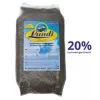
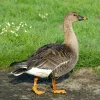

Floatable special rearing feed for all types of aquatic ornamental fowl - especially for the cultivation of trees as well as greening ducks.
This well-balanced complete feed with 20% protein content convinces above all by its good compatibility and forms the basis for visibly healthy growth from day one.
Made exclusively from wholesome and selected raw materials, Lundi Micro Regular is also ideally suited for the year-round feeding of waterfowl.
- Maintenance food:
-



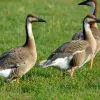

Lundi Regular with a protein content of 20%, valuable Spirulina and high-quality by-products is optimally balanced in its composition maintenance food for water ornamental fowl of all kinds. Especially green teal and Whistling ducks that are not dependent on a very high protein content, are well supplied.
Lundi Regular contains all the minerals and vitamins in full form that are important for the animals. Therefore also suitable as breeding food.


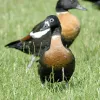


Floating full food for all sea ducks, green ducks, eider ducks and geese, especially in the moulting and breeding phase ideally suited. Packed with wholesome raw materials, natural vitamins and trace elements, this performance food with a protein content of 30% forms the basis for lifelong vitality.


